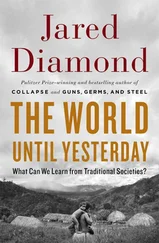Jared Diamond - Guns, Germs & Steel
Здесь есть возможность читать онлайн «Jared Diamond - Guns, Germs & Steel» весь текст электронной книги совершенно бесплатно (целиком полную версию без сокращений). В некоторых случаях можно слушать аудио, скачать через торрент в формате fb2 и присутствует краткое содержание. Жанр: 105. Описание произведения, (предисловие) а так же отзывы посетителей доступны на портале библиотеки ЛибКат.
- Название:Guns, Germs & Steel
- Автор:
- Жанр:
- Год:неизвестен
- ISBN:нет данных
- Рейтинг книги:5 / 5. Голосов: 1
-
Избранное:Добавить в избранное
- Отзывы:
-
Ваша оценка:
- 100
- 1
- 2
- 3
- 4
- 5
Guns, Germs & Steel: краткое содержание, описание и аннотация
Предлагаем к чтению аннотацию, описание, краткое содержание или предисловие (зависит от того, что написал сам автор книги «Guns, Germs & Steel»). Если вы не нашли необходимую информацию о книге — напишите в комментариях, мы постараемся отыскать её.
Guns, Germs & Steel — читать онлайн бесплатно полную книгу (весь текст) целиком
Ниже представлен текст книги, разбитый по страницам. Система сохранения места последней прочитанной страницы, позволяет с удобством читать онлайн бесплатно книгу «Guns, Germs & Steel», без необходимости каждый раз заново искать на чём Вы остановились. Поставьте закладку, и сможете в любой момент перейти на страницу, на которой закончили чтение.
Интервал:
Закладка:
YALI'S QUESTION • 27
research. However, throughout my school and undergraduate years, my training was mainly in languages, history, and writing. Even after deciding to obtain a Ph.D. in physiology, I nearly dropped out of science during my first year of graduate school to become a linguist.
Since completing my Ph.D. in 1961, I have divided my scientific research efforts between two fields: molecular physiology on the one hand, evolutionary biology and biogeography on the other hand. As an unforeseen bonus for the purposes of this book, evolutionary biology is a historical science forced to use methods different from those of the laboratory sciences. That experience has made the difficulties in devising a scientific approach to human history familiar to me. Living in Europe from 1958 to 1962, among European friends whose lives had been brutally traumatized by 20th-century European history, made me start to think more seriously about how chains of causes operate in history's unfolding.
For the last 33 years my fieldwork as an evolutionary biologist has brought me into close contact with a wide range of human societies. My specialty is bird evolution, which I have studied in South America, southern Africa, Indonesia, Australia, and especially New Guinea. Through living with native peoples of these areas, I have become familiar with many technologically primitive human societies, from those of hunter-gatherers to those of tribal farmers and fishing peoples who depended until recently on stone tools. Thus, what most literate people would consider strange lifestyles of remote prehistory are for me the most vivid part of my life. New Guinea, though it accounts for only a small fraction of the world's land area, encompasses a disproportionate fraction of its human diversity. Of the modern world's 6,000 languages, 1,000 are confined to New Guinea. In the course of my work on New Guinea birds, my interests in language were rekindled, by the need to elicit lists of local names of bird species in nearly 100 of those New Guinea languages.
Out of all those interests grew my most recent book, a nontechnical account of human evolution entitled The Third Chimpanzee. Its Chapter 14, called "Accidental Conquerors," sought to understand the outcome of the encounter between Europeans and Native Americans. After I had completed that book, I realized that other modern, as well as prehistoric, encounters between peoples raised similar questions. I saw that the question with which I had wrestled in that Chapter 14 was in essence the question Yali had asked me in 1972, merely transferred to a different part of
2, 8 • PROLOGUE
the world. And so at last, with the help of many friends, I shall attempt to satisfy Yali's curiosity—and my own.
This book's chapters are divided into four parts. Part 1, entitled "From Eden to Cajamarca," consists of three chapters. Chapter 1 provides a whirlwind tour of human evolution and history, extending from our divergence from apes, around 7 million years ago, until the end of the last Ice Age, around 13,000 years ago. We shall trace the spread of ancestral humans, from our origins in Africa to the other continents, in order to understand the state of the world just before the events often lumped into the term "rise of civilization" began. It turns out that human development on some continents got a head start in time over developments on others.
Chapter 2 prepares us for exploring effects of continental environments on history over the past 13,000 years, by briefly examining effects of island environments on history over smaller time scales and areas. When ancestral Polynesians spread into the Pacific around 3,200 years ago, they encountered islands differing greatly in their environments. Within a few millennia that single ancestral Polynesian society had spawned on those diverse islands a range of diverse daughter societies, from hunter-gatherer tribes to proto-empires. That radiation can serve as a model for the longer, larger-scale, and less understood radiation of societies on different continents since the end of the last Ice Age, to become variously hunter-gatherer tribes and empires.
The third chapter introduces us to collisions between peoples from different continents, by retelling through contemporary eyewitness accounts the most dramatic such encounter in history: the capture of the last independent Inca emperor, Atahuallpa, in the presence of his whole army, by Francisco Pizarro and his tiny band of conquistadores, at the Peruvian city of Cajamarca. We can identify the chain of proximate factors that enabled Pizarro to capture Atahuallpa, and that operated in European conquests of other Native American societies as well. Those factors included Spanish germs, horses, literacy, political organization, and technology (especially ships and weapons). That analysis of proximate causes is the easy part of this book; the hard part is to identify the ultimate causes leading to them and to the actual outcome, rather than to the opposite possible outcome of Atahuallpa's coming to Madrid and capturing King Charles I of Spain.
Part 2, entitled "The Rise and Spread of Food Production" and con-
YALI'S QUESTION • 29
sisting of Chapters 4-10, is devoted to what I believe to be the most important constellation of ultimate causes. Chapter 4 sketches how food production—that is, the growing of food by agriculture or herding, instead of the hunting and gathering of wild foods—ultimately led to the immediate factors permitting Pizarro's triumph. But the rise of food production varied around the globe. As we shall see in Chapter 5, peoples in some parts of the world developed food production by themselves; some other peoples acquired it in prehistoric times from those independent centers; and still others neither developed nor acquired food production prehistorically but remained hunter-gatherers until modern times. Chapter 6 explores the numerous factors driving the shift from the hunter-gatherer lifestyle toward food production, in some areas but not in others.
Chapters 7, 8, and 9 then show how crops and livestock came in prehistoric times to be domesticated from ancestral wild plants and animals, by incipient farmers and herders who could have had no vision of the outcome. Geographic differences in the local suites of wild plants and animals available for domestication go a long way toward explaining why only a few areas became independent centers of food production, and why it arose earlier in some of those areas than in others. From those few centers of origin, food production spread much more rapidly to some areas than to others. A major factor contributing to those differing rates of spread turns out to have been the orientation of the continents' axes: predominantly west-east for Eurasia, predominantly north-south for the Americas and Africa (Chapter 10).
Thus, Chapter 3 sketched the immediate factors behind Europe's conquest of Native Americans, and Chapter 4 the development of those factors from the ultimate cause of food production. In Part 3 ("From Food to Guns, Germs, and Steel," Chapters 11-14), the connections from ultimate to proximate causes are traced in detail, beginning with the evolution of germs characteristic of dense human populations (Chapter 11). Far more Native Americans and other non-Eurasian peoples were killed by Eurasian germs than by Eurasian guns or steel weapons. Conversely, few or no distinctive lethal germs awaited would-be European conquerors in the New World. Why was the germ exchange so unequal? Here, the results of recent molecular biological studies are illuminating in linking germs to the rise of food production, in Eurasia much more than in the Americas.
Another chain of causation led from food production to writing, possibly the most important single invention of the last few thousand years
Интервал:
Закладка:
Похожие книги на «Guns, Germs & Steel»
Представляем Вашему вниманию похожие книги на «Guns, Germs & Steel» списком для выбора. Мы отобрали схожую по названию и смыслу литературу в надежде предоставить читателям больше вариантов отыскать новые, интересные, ещё непрочитанные произведения.
Обсуждение, отзывы о книге «Guns, Germs & Steel» и просто собственные мнения читателей. Оставьте ваши комментарии, напишите, что Вы думаете о произведении, его смысле или главных героях. Укажите что конкретно понравилось, а что нет, и почему Вы так считаете.










